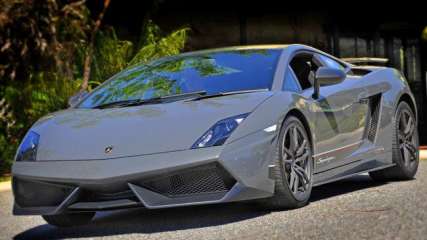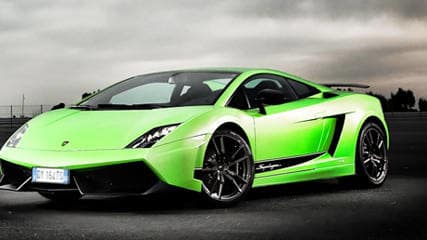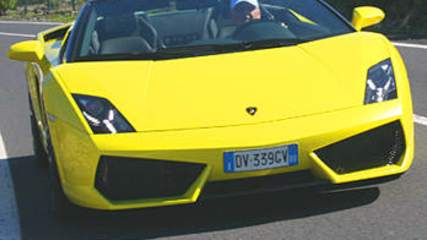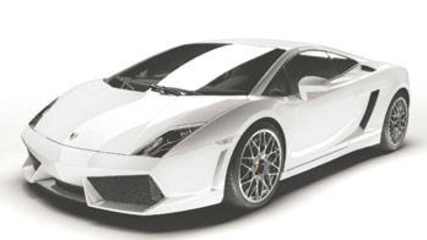Lamborghini Aventador, Gallardo Spyder and Gallardo Superleggera 2012 Review
By Paul Gover · 20 Feb 2012
When the cars involved are all from Lamborghini, one of the world's most exotic brands, the whole deal sounds so much sweeter. And it is. But what if I tell you we never get much beyond the posted 130km/h limit, that a metre of snow has created traffic chaos in a string of tiny hilltop towns, and that the highlight of the day is a stand-off with thePolizia over documents for the cars and drivers? Oh, and lunch, of course. But that's all ahead as we roll into Sant' Agata, the home of Lamborghini since it was set up by a humble tractor maker in the 1960s, for a deep-dip day of driving in the latest hero cars for the Italian brand. It's a dream come true, a big tick on the bucket list, and a chance to discover why some people really choose a Lamborghini ahead of a Ferrari - or a perfectly reasonable new apartment.The Lamborghini brand has always been a bit more exotic and mysterious than mainstream Ferrari, which is just up the road and remains the benchmark for any buyer - or brand - looking to tap the supersports dream. These days it picks up the giant benefit of a place in the Volkswagen Group, thanks to its Audi ownership. That means German efficiency with Italian passion, and that's far better than doing things the other way around.Carsguide is in Italy with Lamborghini for the first - yes the very first - official press visit in a generation, covering everything from technical briefings and a walk down the production line to a sneak peek into the carbon fibre research laboratory and a long lingering look at the museum. What emerges is an exotic brand with a sense of style and humour, but a very sharp approach to its cars and customers.The Gallardo changed Lamborghini forever, giving the company the credibility and reliability to put the brand on shopping lists around the world. Now there is the new flagship, the $754,600 Aventador with the V12 engine and 350km/h top speed.But when it's flashing a warning about icy driving, and the day quickly degenerates into a slow-speed tour through some beautifully snowed-in countryside, even the Aventador loses its shine. And literally, too, with so much slush about.But then comes a tunnel and, with a volley of rapid-fire downshifts, the Aventador and the Gallardo Superleggera are howling like banshees and everything is right in the world. I'm smiling, the cars are happy, and it's a great day.AVENTADOR:Ferruccio Lamborghini chose a V12 engine when he set up in opposition to Enzo Ferrari in 1963 and his company has continued down the same road for close to 50 years.The latest V12 flagship is the Aventador, one of the most exotic looking cars on the road in 2012 and one that ticks almost every box for teen-aged dreamers and 50-something magnates. It really is that special.The Aventador is a two-seat supersports car with a 6.5-litre engine that punches out 520 kiloWatts to feed through a high-tech all-wheel drive system. Did someone mention Audi, which owns Lamborghini?The first Aventadors have just reached Australia and already there is a two-year waiting list, even though the bottom line starts at $754,600 without worrying about on-road costs, insurance or a few personal tweaks in colour or trim.Value? It's not really something you can assess without access to James Packer's vault.But there is plenty of technology, starting with the world's first full carbon fibre monocoque. That's the centre of the car, where the people sit, and it is the foundation for the suspension and the rest of the mechanical package that hangs off at either end.The Aventador has a computer-controlled seven-speed robotised manual gearbox that's capable of F1-speedy shifts, but it's also programmed to shift quickly to the high gears to maximise fuel economy - rated at 19.1 litres/100km - and minimise emissions.No-one from ANCAP is intending to crash-test an Aventador, but the car has a super-rigid structure, airbags and the usual ESP and ABS systems to keep its two occupants safe. And anyone driving the car at 110km/h is so far from the danger zone that the real threat is boredom and a micro-sleep.You start the Aventador by lifting a small red flap - like the ones covering the triggers for rockets - after sliding deeply into the car through its signature scissor door. The sound is magic V12 music, although surprisingly muted.Tug a shift paddle and it's time to get moving, with the computer power easing the clutch and shifting gears as well as any of the latest double-clutch packages. The Lamborghini feels very wide, the ride is super-firm, and there are scary thoughts about what could happen if I put my foot on the floor.But there is no chance today, with an Audi Q7 running as the pace car and enforcing a quiet pace on slick and icy roads. A couple of times I get brave and belt it up beyond 8000 revs, enjoying the sort of thrust usually reserved for Formula One drivers.One time, with the speedometer hovering around 120km/h, I give the Aventador its head and the traction control light blinks furiously, the steering tugs and hunts, and I realise the big beast is not happy.Me? Perhaps. It's great to get time in the Aventador but now I cannot wait for the next time, and hopefully some Australian sunshine and a wide-open racetrack with no speed limits and no Q7s.GALLARDO SPYDER:It's easy to stay warm in a droptop Gallardo, even when the outside temperature is barely above freezing.The cabin is set deeply into the middle of the car, there are heated seats, and the shape of the wedgy body keeps the wind flowing smoothly over your head.Of course, there is also the warm glow you get from driving such a rare beast.The Gallardo Spyder is an effective convertible conversion on the V10-powered Lamborghini that pays the bills, and returns a profit to Audi, in the 21st century. The Gallardo has been teased and tweaked in a number of directions, and the Spyder is the one that works for a lot of people.The roof is electric, as you'd expect, but still a canvas job at a time of clamshell hardtops. It works, but it doesn't look as nice as some cars that cost far less than its $515,000.The mechanical package is built up from a 5.2-litre V10 with 343 kiloWatts and a 0-100km/h sprint time o just 4.0 seconds, thanks to all-wheel drive. There is a six-speed e.gear transmission and all-wheel drive, as well as a cabin in typical Lamborghini leather but with switchgear and displays that are more obviously borrowed from Audi than the lineup in the Aventador.The Spyder can easily run with the bulls, especially in a land of speed limits and Polizia, and it does it with a little more panache and excitement than a regular Gallardo.I can feel a little slackness in the chassis, though not a lot, but the Spyder is still a car that can surprise and delight. It's just not for me.GALLARDO SUPERLEGGERA:Now we're talking. This car is a lightweight - in the best possible way.The Lamborghini team created the new pacemaker in the Gallardo lineup with lashings of lightweight carbon fibre to trim the bottom line by 70 kilograms while holding onto 419 kiloWatts of power and all-wheel drive.That means 0-100km/h in a time warping 3.4 seconds, a 325 km/h top speed and a searing $542,500 price tag in Australia. That means it costs more than a Ferrari 458 Italia.But Lamborghini says the Superleggera is a car for people who enjoy cars and driving, and makes the point with kermit green bodywork on the test car at Sant' Agata. It also has ripper sports bucket seats, a suede-wrapped steering wheel, and carbon fibre everything from the door trims to a rear wing that produces real downforce.The Superleggera is the evil member of our little Lamborghini train, always teasing the driver with the promise of instant feedback, a howling soundtrack, and the ability to compress time and space.But it feels edgy and nervous, which is ideal for a racetrack but less encouraging on a cold day with changeable conditions including water, sludge and a little snow and ice.When you strap into this Gallardo you have to pay attention and be prepared for action.That's what makes it so enjoyable, even just squirting away from traffic lights or easing through a couple of right-angled bends.The Superleggera is the car that Lamborghini puts up against Ferrari and also the McLaren MP4-12C, and it makes a powerful statement. It's not for everyone, but for the people who want one it ticks all the boxes.







